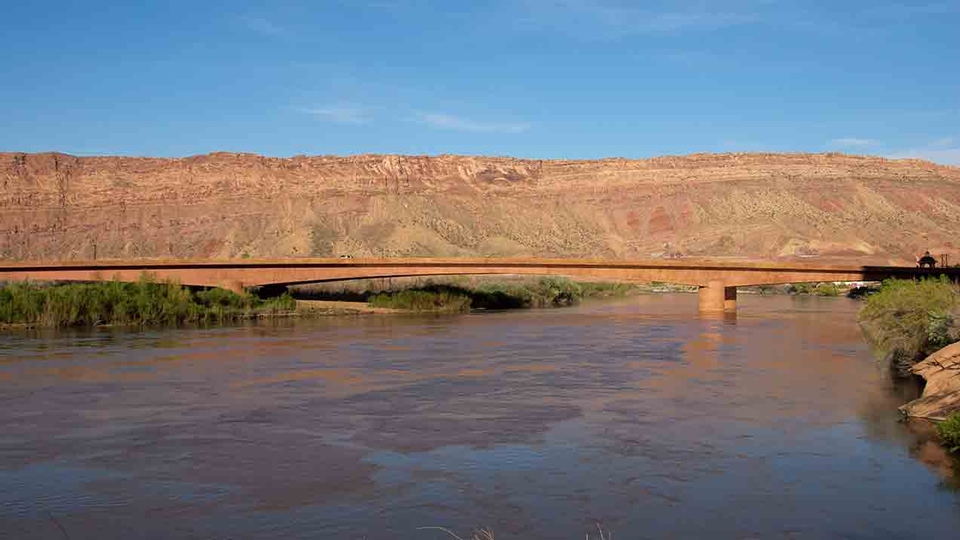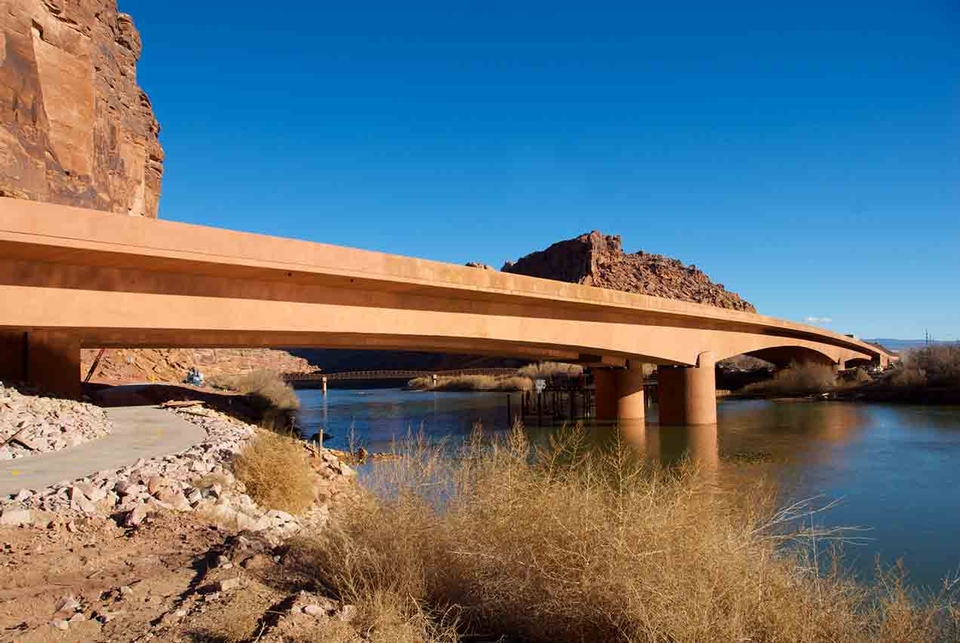US 191 Colorado River Bridge – Moab, Utah
The US 191 Colorado River Bridge is the gateway to Arches National Park, Canyonlands National Park, Dead Horse Point State Park, white-water rafting down the Colorado River, and hundreds of miles of world famous, multi-use trails.
Utah’s first concrete segmental bridges were built from above, cast-in-place in balanced cantilever, to minimize impact to the channel and to allow for continual recreational use of the river and surrounding trails during construction. The 440 foot main span minimizes the bridge footprint, and spans a sensitive environment home to several endangered species.
The 1,022 foot long twin structures were completed in 21 months, in December 2010, and one year ahead of the original Engineer’s schedule, and for less than $290 per square foot, nearly $3M under the Engineers Estimate.
Innovation of Design and/or Construction
The US 191 Colorado River Bridge primarily serves as a transport for tourism, and the revenue generated from tourism is the mainstay of the local economy. The Project Team recognized that the success of this project ultimately depended on providing the community with a new river crossing that was designed to blend in and allow the natural landscape to remain in the forefront, and could be constructed while minimizing impacts to tourism and the environment.
The Project Team developed and presented to the community a concept that mimicked the graceful form of an iconic local landmark: Landscape Arch. The shallow, arched profile of Landscape Arch is naturally structurally efficient and lends itself well to variable depth, post-tensioned, concrete segmental box girder technology constructed in balanced cantilever. This structure type allows the bridge to be built top-down with the use of traveling forms, with little environmental impact to the river. The resulting long spans allowed for only one pier in the river, three fewer than the previous bridge. In addition, the concrete mix was engineered to have a service life of over 100 years, which will dramatically reduce the life-cycle impact to the environment. Artfully applied, non toxic, water-based mineral stain blends the concrete structure seamlessly with the complex palette of the surrounding sandstone cliffs. The bridge is also Utah’s longest concrete span.
Rapid Construction
The first of the twin structures was constructed completely off-line so as to not interrupt traffic, demolition was completed off-line after traffic had moved over to the new bridge, and traffic was switched seamlessly between the twin structures to allow for staining operations to progress unimpeded. The Contractor achieved casting rates of six segments per week with two sets of form-travelers, and the twin 1,022 foot bridges were completed in just 21 months, nearly a year faster than the original project schedule.
Aesthetics and/or Harmony with the Environment
One of the Project Team’s main objectives was to design a bridge that was aesthetically in harmony with the surrounding environment and that physically minimized impact to the Colorado River and the surrounding wetlands.
The key stakeholders representing local government, business and property owners, community and recreational groups, and National Parks and Lands services developed the Project theme, “A Bridge in Harmony with the Environment.” Key aesthetic concepts, such as the rock texture found on all bridge elements in contact with the ground and an environmentally conscious, water-based stain artfully applied to the whole of the bridge exterior to mimic the modeled look of the cliffs, were also developed. Finally, the bridge profile was modeled after Landscape Arch, which stands in the project-bordering Arches National Park.
The Colorado River is the major source of water for the Southwest and home to protected wetlands, several species of endangered fish, and many species of protected birds. The Project Team minimized impact to this watershed by developing twin, variable depth, post-tensioned, concrete box girder bridges, constructed top-down in balanced cantilever.
Cost Competitiveness
While a long span segmental bridge was the optimal solution for minimizing environmental impact and gaining community acceptance, the Project Team was aware that constructing a bridge of this nature in an isolated part of the country would be challenging. Therefore, several pre-bid meetings were held to educate and attract local contractors so that there would be more competition during bidding, and consequently a reduced cost of construction. This effort was successful in attracting 13 bidders to a relatively isolated project. A local contractor, new to segmental construction, provided the low bid, saving the Owner $3M compared to the Engineers Estimate.
Minimization of Construction Impact on the Traveling Public
The functionally obsolete and fracture-critical existing bridge was replaced with little impact to tourism and with great improvement to public health and safety. Staged construction of the twin bridges kept traffic moving though the corridor while utilizing the footprint of the existing bridge. The structure carrying the southbound lanes was constructed first. All traffic was then shifted to the new southbound structure while the existing bridge was demolished and the northbound structure was built in
its place.
Jury Comments
This project reflects the vision of the local stakeholders by incorporating aesthetic concepts that blend the structure into the natural landscape of the Moab area. Both the owner and contractor were new to segmental construction and were willing to accept the risks necessary to successfully complete the bridge ahead of schedule and under budget.
2011 ASBI Bridge Award of Excellence
Category: Bridges Over Water
State:
Utah
Owner:
Utah Department of Transportation
Owner’s Engineers:
FIGG
Designer:
FIGG
Contractor:
Wadsworth Brothers Construction
Contractor Engineering Services:
Summit Engineering Group, Inc.
Constructability Review/Estimating Services:
FIGG
Construction Engineering Inspection:
FIGG
Form Travelers for Cast-in-Place Segments:
NRS-Asia
Post-Tensioning Materials:
DYWIDAG Systems International, USA, Inc. (DSI)
Bearings:
The D.S. Brown Company
Expansion Joints:
Watson Bowman Acme—A BASF Company
Prepackaged Grout:
Sika Corporation






